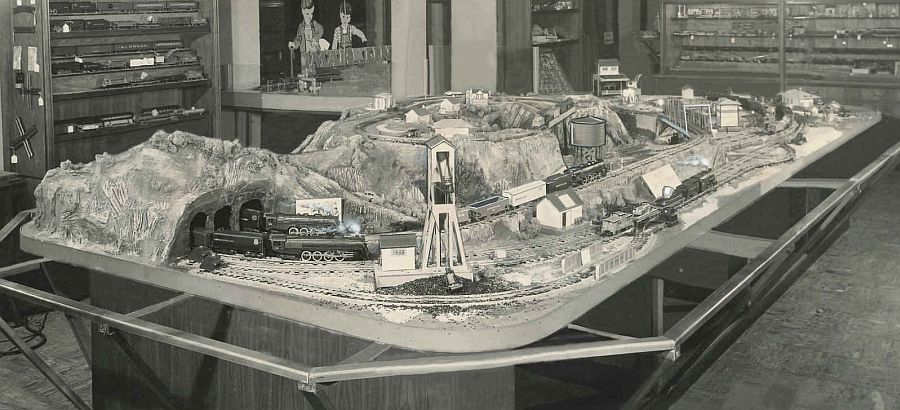F.A.O. Schwarz New York City
The Billi Bowen Layout
In 1949, layout designer Billi Bowen designed a large layout to be placed in the F.A.O. Schwarz store in New York City.
This wasn't the first model railroad Billi Bowen designed. According to the 1940 census, he had been designing model railroads as early as the late 30's and early 40's. The 1940 Census shows that he lived in New York City and his occupation is listed as a builder of railroad exhibits. His employer is listed as the New York World's Fair, a clear indication that he played a part in the model railroad exhibits at that fair. That census also reveals that he was the step-son of Phillips Houghton, a frequent contributor to the model railroad press and one of the authors of the Trend book quoted below.
An article in Railroad Model Craftsman in April 2012, 1 tells us that Billi, or Bill, worked on the second of two indoor layouts at the 1939-1940 New York World's Fair. The first of the indoor World's Fair layouts, "Railroads in Action," is fairly well known. It was viewed in a theater setting that simulated a 24 hour period in the life of a typical railroad of that era. The second layout called "Building the Railroad," which Bowen designed with H. Raymond Bishop of Outwaithe Exhibits, is less well known. It was designed to be viewed close up and so is more detailed than the "Railroads in Action" exhibit.
From this, Billi Bowen went on to produce many other track plans, including the New York F.A.O. Schwarz American Flyer layout, which is probably the utlimate American Flyer Display layout. Many of his other track plans have appeared in the model railroad press throughout the 40's and 50's.
The photo at the top of the page is from the Buckage Collection
and depicts the 1949 layout built by A.C. Gilbert Co. for the
F.A.O. Schwarz toy store in New York City. It is dated
as 1949 by the absence of rubber roadbed and diesel
locomotives, both introduced in 1950. Also both the
layout and a display shelf contain 4904T sets with the 290 locomotive and 3 freight cars,
which was introduced in 1949.
This layout is also definitely from F.A.O. Schwarz. There is a small sign just above the log loader that reads "FAO Schwarz." (See enlarged section below.) The black lines were added in the process of preparing this photo for use as an illustration in the Model Railroad Handbook that came with the Pike Planning Kit.
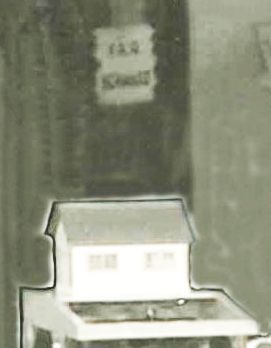
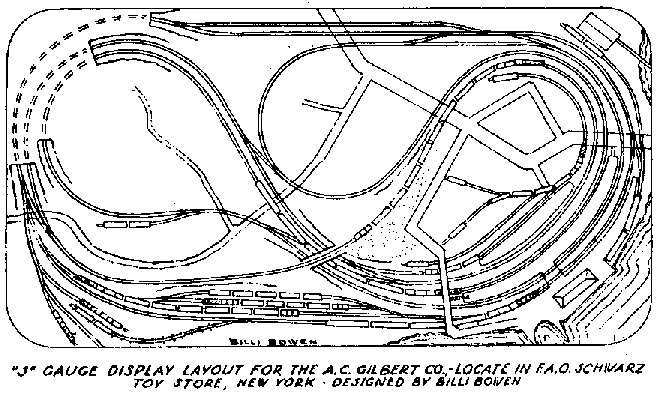
The track plan below is the original Billi Bowen plan for
the F.A.O. Schwarz layout.
Comparing the layout plan above with the photo of the layout, it appears that the layout as built was a somewhat simplified version of the original Bowen design. The passing sidings on the outer loop appear to have been eliminated, as have the connections between the loops. In addition the inner sidings off of the over-under figure eight and the sidings from the outer loop at the lower left corner of the drawing have been simplified. The layout on the Bowen drawing appears to require more space than that occupied by the 1949 layout in the photo.
This layout is clearly a masterpiece of layout design. While the layout may not provide switching action that some model railroaders might desire, it serves the purpose for which it was designed perfectly. It displays a reasonable number of trains in action and requires little supervision to run effectively. Gilbert definitely got what they paid for here. That is probably the reason that several incarnations of this track plan were used by Gilbert for different displays, such as the Jordan Marsh, Sibley, and Boys' Railroad Club. There is currently increased interest in this layout design and several modern layouts utilizing much the same plan have been built, most of which pay homage to the Sibley Layout, which is probably the best known of these designs, but it all began here.
The following quote is
from a “Model Railroading” published in 1956 by Trend Books Incorporated.
It describes the layout provided by A.C.Gilbert to FAO Schwarz.
(pages
17-19)
| Tin-plate can be made interesting and realistic as Billi
Bowen proved with the demonstration layout he designed for
the A. C. Gilbert Co. and which was set up in the F. A. O.
Schwarz Toy Store in New York City (see
diagram). It might properly be called "Hi-Rail,"
as no stock short-radius curves are used, and the switches
were modified to get closer track spacing. The layout
was designed to show as many trains in motion as possible,
in as realistic a setting as could be achieved, eliminating
many of the undesirable features of the usual toy store
tin-plate layout. The scenery was simple; no grandiose painted canyons with big (and out-of-scale) bridges connecting nothing to nowhere; just ordinary rolling country, high enough in the back corner to provide tunnels to break the round-and-round, and on the opposite corner a touch of waterfront to create interesting color and show the reflections of passing trains. Enough streets and buildings were used to give the illusion of a town for the railroad to serve. The roads, fences, etc., ran off the edge of the platform (rather than maintaining the usual deadly parallelism) in order to suggest the continuation of the landscape. There was quite a bit of track, more than would be needed by an individual railroader: loops were kept separate from each other to allow several trains to operate independently. Now for the details of the track plan itself: the outer loop was a single track line with two passing sidings, one in the freight yard and the other at the opposite side of the platform. These were intended to be automatic so that two trains could be run in opposite directions, passing each other at each siding. The next loop toward the center was a single loop folded on itself so that in the center it was a double track (it might be called a "distorted dumbbell"): this was to be equipped with an automatic block so two trains could follow each other counterclockwise. The last loop was a figure eight, crossing over itself, and meant mainly for single train operation. Thus, adding the three separate routes together, five trains could be in operation at the same time, making automatic station stops, and obeying the signals, etc. In addition, the little four-track freight, or rather team-yard, opposite the main passenger station was laid out with a lead long enough to permit an operator to do a lot of switching there and still keep clear of the main line loops. This meant the possibility of six trains in motion. There are several other items in the Bowen layout which don't often find their way into tin-plate layouts (and are rather difficult to do with the limitations of stock curves and switches); in addition to the elimination of parallelism already mentioned, reasonable appearing tunnels with the tracks close enough together to look as if they were not mad at each other: several small spurs leading off to industries (instead of loading directly on the main line); freight yards and engine terminals of adequate size, and yet compact: and the general feeling of integration of closely spaced tracks. As the layout was actually built the area which hid the return loops in the upper left hand corner of the sketch was larger than shown, and was in the form of a plateau. This allowed the placing of a small loop of HO-gauge on the top. Dressed up with trees and a few houses, this smaller train gave the illusion of being far away from the larger trains on the level below, and in this way, avoided the usual mistake of having trains of different sizes running side by side. |
Other F.A.O. Schwarz Layouts
Additional photos of a 1953 F.A.O. Schwarz layout can be seen in the book Toy Train Memories at pages 89 and 93. 2 It is clear that while this layout is different from the 1949 version, it may have been built on the same framework and is located in the same room. The photos below are provided by special arrangement with Kalmbach Publishing Co.
Photos from Toy Train Memories by John Grams - By permission of Kalmbach Publishing
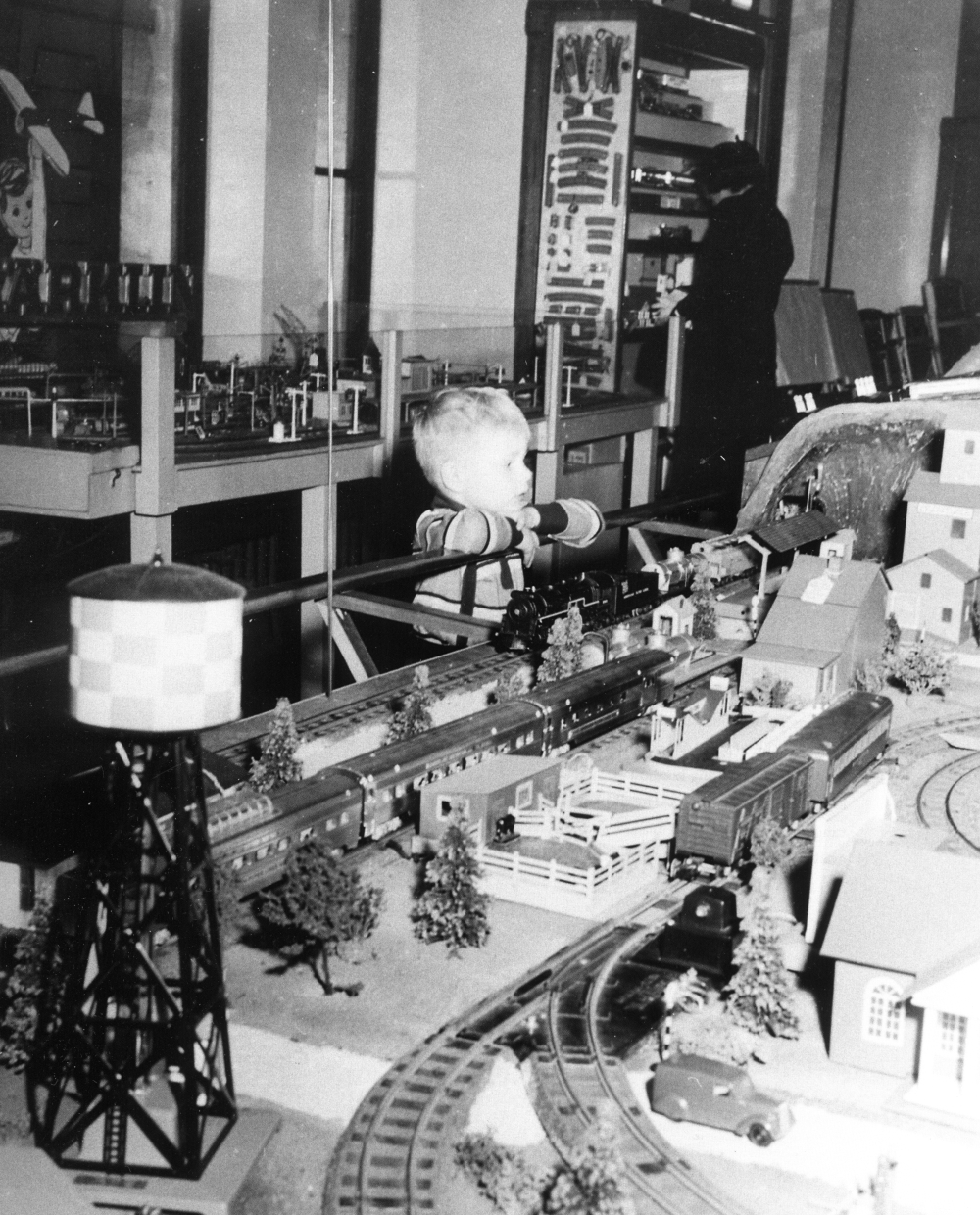
Photo of the 1953 Layout at F.A.O. Schwarz Toy Store
The room is recognizable as the same one that contained the 1949 display shown above.
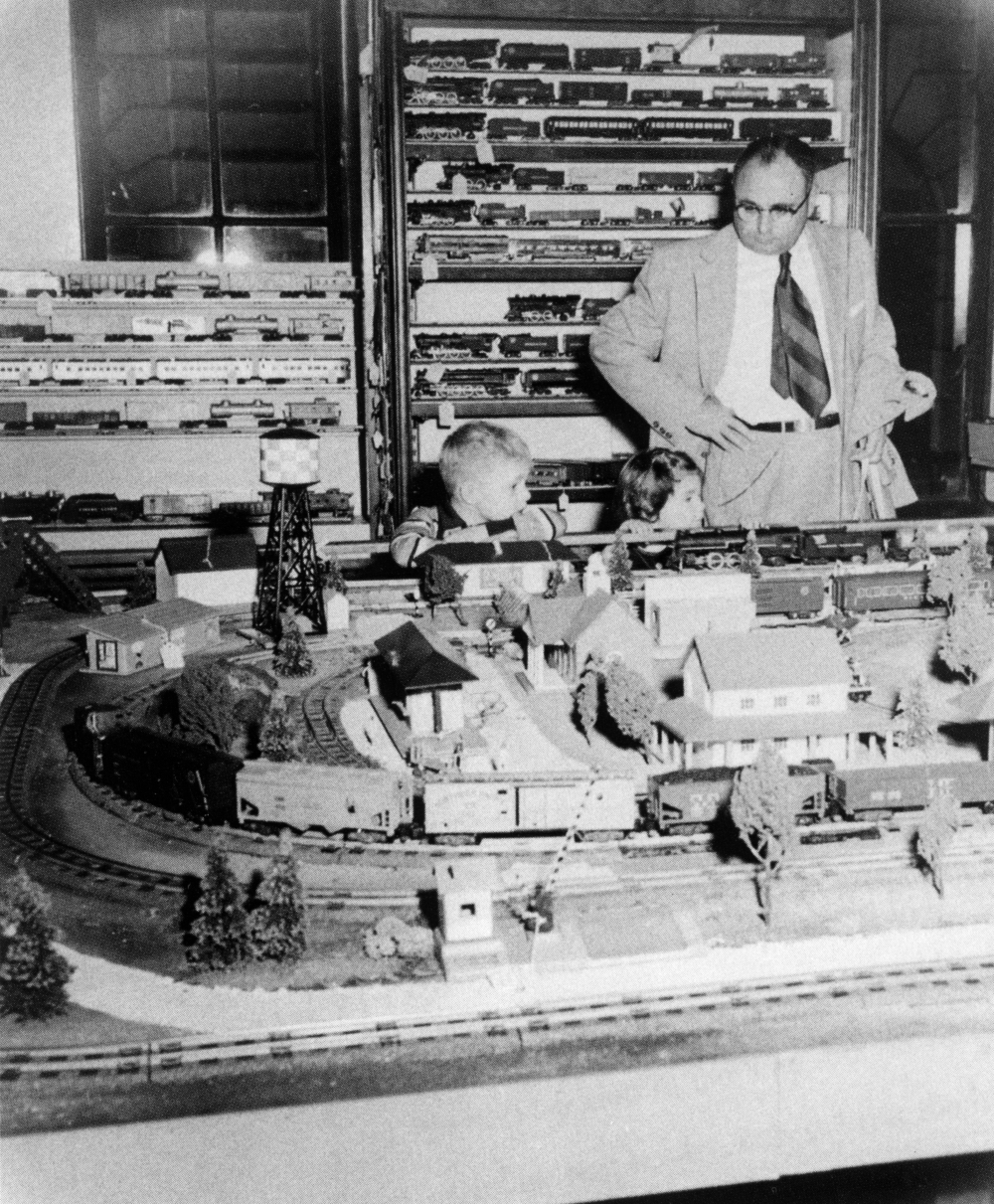
Another photo of the 1953 F.A.O. Schwarz Layout.
As can be seen from the display case on the left, F.A.O. Schwarz also carried Lionel Trains.
The young man in both photos is Mike Novak.
Notes
1 The Last Big Splurge: the 1939-1940 New York Worlds Fair, By Keith Wills, Railroad Model Craftsman, April 2012, page 88
2 Toy Train Memories, by John Grams, pages 89 and 93
Many thanks to Emil Suda for helping track down information on Billi Bowen and to Kalmbach Publishing for permission to use the photos from Toy Train Memories by John Grams.
